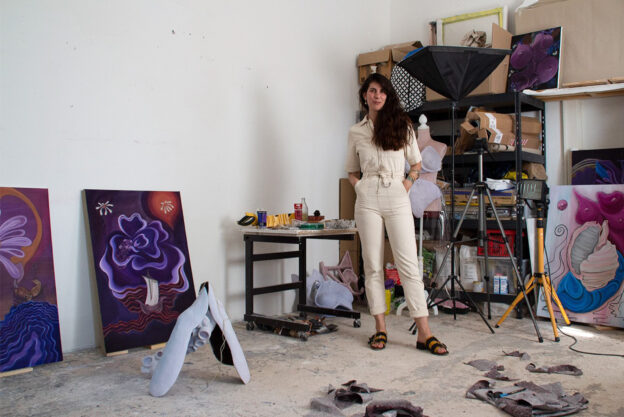Linda Marwan‘s artistic practice focuses on reimagining spaces for nonhumans. The artist’s objective is to foster space for existence that is not dominated by patriarchal ideologies. Including, inequitable structures stemming from a utilitarian perspective of the Anthropos. Her interdisciplinary approach is concerned with using mediums that can examine her subject; from paint and ceramics to digital print. Each piece is in deep conversation with another.
Space and the Other
In her essay The Master’s Tools Will Never Dismantle the Master’s House, Audre Lorde notes how ‘Difference must be not merely tolerated, but seen as a fund of necessary polarities between which our creativity can spark like a dialectic.’ Linda sees the power in beings that are othered in our world. The other, being any life form outside of the traditional patriarchal position that has established these systems of inequity. She extracts an understanding of how these inequities present themselves through space and reframes this in visual installations.
The artist finds that by composing her pieces in installations, the networks and dialogue become more animated. Linda’s installations create a space of belonging. They provide a place to break away from the deep-rooted oppressive structures of our everyday, a breath of relief and allow us to feel the promise of connection.
Linda Disrupts our Experience of Knowledge
In her studio, we are surrounded by paintings and sculptures. They are hybrids of anthropomorphic and octopus forms. While Linda speaks to me, her passion for the concerns projected through her art is visceral. She is concerned with inclusivity and accessibility in being human, and especially how it affects nonhumans. Referencing Rosi Braidotti, Linda expresses how she has found that philosophy and feminist theory generates her work. Rosi Braidotti explores how our knowledge is dominated by power relations that have led to inequitable understanding of value. Linda takes this information and questions why these structures are accepted.
images by PILOTENKUECHE or provided by the artist
Her sculptures provoke thinking about the associations we have been taught to recognise as human. Linda explores how an octopus is a very intelligent being, yet they along with so many others, are polarised from the human. Casting from her own body, as well as tying them with sculpted octopus forms; Linda explains how feminist philosophy suggests that everything outside of patriarchal hierarchies can be considered as nonhuman. When unravelling these systems of human knowledge, it extracts the connections of taxonomic hierarchy, colonialism, racism, sexism, transphobia, homophobia, ableism and the list goes on. Linda’s pastel forms fantasize about models of change in our understanding of how we can exist. These sculptures are sensitive and sensual, focusing on the intimacy of nature and knowledge.
Non-Human Collectivity and Artificial Intelligence
Linda’s practice is unbuilding and building worlds through images, on images, on images. Her painting, Orcinus orca contemplating what to do about humanity, features orca whales, manga style portraits and gothic architecture. She fed a photograph of this painting into a system of artificial intelligence that processes the image using a series of algorithms to identify its elements. Linda then took these results and materialised them into a series of printed banners. These were also presented as part of her larger installation; Why is it always mimicry?, in the recent exhibition Dark Hope Respite at PILOTENKUECHE. Her printed banners confront the ways neural networks are alarming.
The works enlist a series of algorithms that aim to mimic the way the human brain identifies relationships within a set of data. She notes how it identified the gothic architecture, manga style portraits in the painting, but not the orca whales. These technologies are designed and trained to see the world. But who is behind the curtain? Many of the things we take for fact are designed by those who benefit most from the structures of inequity. Linda plays with these perceptions, exploring how our society values human and nonhuman.
Valuing Ecological Networks
Linda’s artistic practice reminds me of the work of artist Camille Henrot, who is also interested in the ways we understand the world. Henrot, speaking of her work Grosse Fatigue, 2013, expresses; ‘…what interests me are the problems raised by the scientific approach when it engages with human nature and with Nature itself.’ Using imagery Henrot questions how we can understand the world with so much content to process. Similarly, Linda’s work comments on the density of information we are exposed to, particularly through visual cultures.
In her installation Why is it always mimicry? Linda shapes symbols on the floor out of soil that she came across in her research. These symbols date back up to 40,000 years and have been found in cave paintings all over Europe. Her use of soft organic materials in her making is purposeful in its connection with her subject. Linda’s work is layered in visual and theoretical networks. She opens space for us to contemplate systems and values in an approachable and inclusive way. Subsequently, since exploring her practice more and more, I know Linda’s art will occupy space in my mind for time to come.
Written by Kat Lafferty
Keep up to date with Linda’s work on her Instagram. As a local participant, her work was a part of the recent exhibition Dark Hope Respite at PK.
about us
PILOTENKUECHE International Art Program is a full program that includes international artists, local artists, curators and interns. Our mission is to open cultural dialogue through the arts.


















